Grain sorghum is the sixth most valuable field crop grown in Missouri. Unfortunately, diseases damage this crop, causing lower yields and reduced grower profits. Fortunately, most diseases of grain sorghum can be managed by planting resistant varieties and adopting certain cultural practices. This publication will help you identify diseases in your grain sorghum crop and select the best disease management tactics.
Diseases are difficult to control in grain sorghum after they develop. Therefore the most inexpensive, efficient, and effective disease control procedures are preventive:
- Plant high-quality seed.
- Plant into fertile soils that have a pH of 6.0 to 6.5.
- Plant in soils with average daily soil temperatures of 70 degrees F or greater.
- Plant in well-drained fields.
- Plant disease-resistant varieties.
- Plant in fields free of johnsongrass.
- Plant varieties with good stalk strength.
- Seed for a population of 90,000 to 100,000 plants per acre for nonirrigated fields, and 100,000 to 120,000 plants per acre for irrigated fields.
- Rotate crops.
Accurate disease diagnosis is important and should always be completed before changing production practices. Contact your local MU Extension center or the MU Plant Diagnostic Clinic, in Columbia, 573-882-3019, for help with diagnosis and current disease management information. More information is available at cafnr.missouri.edu/research/.
Seed and seedling diseases
Every year, seed and seedling diseases of grain sorghum are common in Missouri. When severe, these diseases kill seedlings, causing low plant populations. Costly replanting may then be necessary.
Several different, normally harmless pathogens that live in the soil can attack grain sorghum seed and seedlings. The organisms most commonly involved are Fusarium, Pythium and Rhizoctonia. Infection by these fungi can be enhanced by low soil pH and cool soil temperature.
Symptoms
Healthy grain sorghum roots are white and firm, and a stand of healthy seedlings is uniform with no skips. In contrast, infected roots have dark red to black rotten areas (Figure 1). The leaves of diseased seedlings may wither or appear pale-green, and the plants may be stunted. Severely damaged plants will die, resulting in thin stands or frequent skips in rows. Surviving plants are often weak, unproductive and more susceptible to other diseases and environmental stresses.
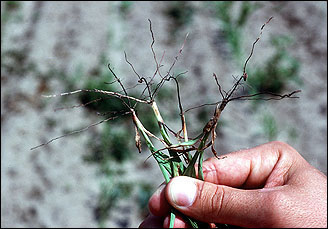 Figure 1
Figure 1
Black roots are an indication of seedling disease in grain sorghum.
Management
- Plant high-quality seed that has been treated with a broad-spectrum fungicide. Most hybrids sold commercially are of high quality and are so treated.
- Plant into fertile soils that have a pH of 6.0 to 6.5. Plants growing in low pH soil, e.g., pH 5.0, are more likely to be infected by Fusarium.
- Plant in soils with average daily soil temperature of 70 degrees F or higher. This favors rapid seed germination and seedling establishment.
- Avoid planting into poorly drained fields. Field drainage can be improved by breaking up hard pans and compacted layers and by creating improved field drainage patterns.
- Avoid excessively high plant populations. Farmers may apply Quadris infurrow at planting for protection against seedling diseases.
Diseases of the leaves
Leaf diseases are common on grain sorghum in Missouri. They are caused by several organisms, both bacteria and fungi, that attack leaves in the summer and lie dormant in plant debris in the winter. Disease severity varies with the weather and the grain sorghum hybrid.
Bacterial stripe
Bacterial stripe, caused by Burkholderia andropogonis, is characterized by long, narrow, red stripes, first seen on the lower leaves. The stripes range from 1/4 inch to more than 9 inches in length and tend to be confined between the leaf veins.
Bacterial streak
Bacterial streak, caused by Xanthomonas campestris pv. holcicola, is evident as narrow, yellow stripes about 0.1 inch wide and 1 to 6 inches long (Figure 2). These stripes may occur on plants any time from seedling stage to near maturity, but they are usually first apparent on lower leaves. Eventually, red-brown blotches appear in the streaks, which may broaden into oval spots with tan centers and narrow, red margins.
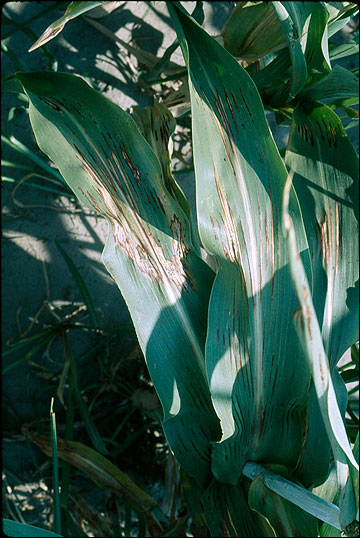 Figure 2
Figure 2
Leaf injury due to bacterial streak.
Bacterial spot
Bacterial spot, caused by Pseudomonas syringae, is characterized by small, irregular shaped, tan lesions with dark margins.
The bacteria causing these three diseases are believed to survive from one season to another in both seed and infected plant debris. They spread from plant to plant by wind-blown, splashing rain and by insects. These diseases are most severe during warm (75 to 80 degrees F), moist weather.
Leaf blight
Leaf blight, target spot, gray leaf spot, zonate leaf spot, rough spot, sooty stripe and rust are some of the leaf diseases of grain sorghum caused by fungi (Figures 3 and 4). These diseases and the symptoms they cause are listed in Table 1. The symptoms you see in the field may vary slightly from the symptoms described here due to the weather and the hybrid.
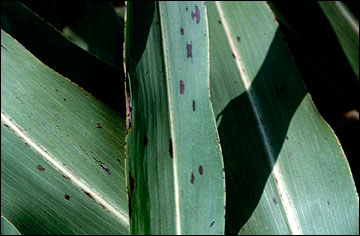 Figure 3
Figure 3
Leaf spots due to gray leaf spot.
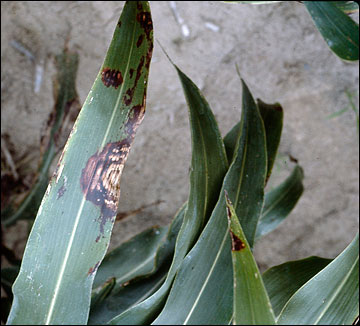 Figure 4
Figure 4
Target-like lesion on leaf due to zonate leaf spot.
Management
- Rotate crops.
- Plant tolerant varieties.
- In poorly rotated fields, till old crop debris into the soil before planting. *Quadris is EPA labeled for application to grain sorghum foliage for protection against anthracnose and gray leaf spot.
Table 1
Leaf symptoms of grain sorghum diseases caused by fungi
| Disease name | Lesion shape | Lesion size | Lesion color | Other characteristics |
|---|---|---|---|---|
| Leaf blight (Exserohilum turcicum) | Irregular and long | 1 inch long or longer | Gray with tan-red borders | |
| Target spot (Bipolaris sorghicola) | Round, elliptical spots | 1/8 inch to 1 inch | Tan with red borders | |
| Gray leaf spot (Cercospora sorghi) | Elongate to rounded | 1/4 inch or more | Dark purple | Old lesions may be gray |
| Zonate leaf spot (Gloeocercospora sorghi) | Bull's-eye appearance | 1/4 inch to 2 inches | Alternating dark purple and tan bands | Lesions resemble a bull's-eye target |
| Rough spot (Ascochyta sorghi) | Broad elliptical | 1/4 inch to 1/2 inch | Tan centers with purple borders | Center of the lesion is rough to the touch (feels like fine sandpaper) |
| Sooty stripe (Ramulispora sorghi) | Elongate elliptical | 3 to 5 inches long, 3/4 inch wide | Tan center, purple margins | Centers of old lesions will appear sooty |
| Rust (Puccinia purpurea) | Round to elliptical raised pustules or blisters | 1/16 inch to 1/8 inch | Light red-brown | Usually confined to older leaves |
Diseases of leaves and stems
Anthracnose
Anthracnose, caused by Colletotrichum graminicola, can develop on both leaves and stems of susceptible plants. This disease is most serious in the very humid Gulf Coast regions of the United States, but it can be a problem in Missouri.
Symptoms
Small (0.1 to 0.25 inch), circular, red lesions with a distinct margin may appear on susceptible leaves in midsummer and cause defoliation. In severe cases, plants may die before maturation. These lesions can enlarge slightly in humid weather. Tan spots with red-purple margins may develop on upper portions of stalks. The inside of these stalks will be brick red interspersed with the normal white color of healthy tissue. Diseased stalks lodge at the point of infection, and yields may be reduced.
Management
- Plant resistant hybrids.
- Eliminate other susceptible plants such as johnsongrass.
- Rotate crops.
- In poorly rotated fields, plow under infested residue where erosion is not a problem. Apply Quadris to foliage.
Sorghum downy mildew
Sorghum downy mildew, caused by Peronosclerospora sorghi, was first reported in Missouri in the early 1970s. This disease has not become a serious problem in Missouri, but it has caused significant losses in several southern states and especially in the coastal regions.
Symptoms
Light, yellow-green streaks may develop on leaves of infected plants, and a cottonlike fungal growth will be visible on the underside of the infected leaves. Late in the season, infected leaves appear shredded as if damaged by hail. Plants may be partially or completely sterile.
Management
- Plant resistant varieties.
- Rotate with cotton, wheat, soybeans or a forage crop.
Crazy top
Crazy top is caused by the fungus Sclerophthora macrospora. The fungus generally overwinters in grasses in ditches, and in the spring it can spread in overflow water from the ditch into the field. It can infect grain sorghum plants it contacts. This disease is generally not serious in Missouri.
Symptoms
Infected plants have thickened, puckered leaves and may tiller excessively (Figure 5). The newest leaves may roll up and twist, resembling damage caused by acetanilide herbicides such as Lasso and Dual. Infected plants usually survive but do not produce grain.
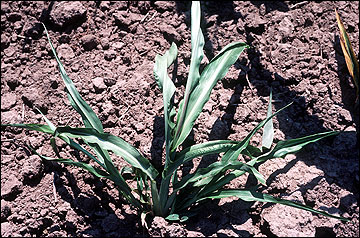 Figure 5
Figure 5
Puckered, rolled leaves and excessive tillering are symptoms of crazy top.
Management
- Improve drainage to prevent water overflowing from ditches into the field.
- Crop rotation is not useful, because the fungus can infect many other grasses such as corn, wheat, rice, crabgrass and foxtail.
- No varieties are resistant, but some are tolerant.
Maize dwarf mosaic virus
Maize dwarf mosaic virus (MDMV) has caused injury to grain sorghum in Missouri, but only in fields where johnsongrass is present. The virus overwinters in the underground rhizomes of johnsongrass. Shoots produced from these rhizomes in spring will be infected, and the virus can be moved by aphids (corn leaf aphid and greenbugs) from those shoots to other susceptible plants like grain sorghum and corn.
Symptoms
MDMV-infected plants exhibit a distinctive mottling of leaves (Figure 6). When compared with healthy leaves, diseased leaves are yellow with light green islands. These symptoms are more evident on young than old leaves. Symptoms generally are less visible on plants in the boot stage. Mottling is the most common leaf symptom, but other symptoms may occur. When temperatures fall below 55 degrees F, infected leaves may turn red, then elongated tan stripes with red margins develop on the leaves. Severely infected plants frequently die, while those that survive will be stunted and may fail to produce a normal head.
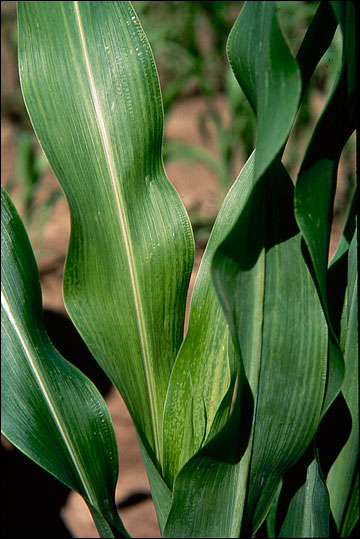 Figure 6
Figure 6
Mottling, yellow leaf with light green areas due to maize dwarf mosaic virus.
Management
- Plant tolerant varieties.
- Eliminate rhizome johnsongrass in the field.
- Killing the aphids that spread the disease will not reduce MDMV infections. Thus, use of insecticides in the management of MDMV is not recommended.
Root and stalk diseases
Root and stalk rots cause more damage to grain sorghum in Missouri than any other disease. Affected plants usually produce poorly and may lodge. Charcoal rot is the most common and damaging stalk rot in Missouri. However, stalk rots caused by other fungi (Fusarium, Pythium and Periconia) can be a problem.
Charcoal rot
Charcoal rot, caused by Macrophomina phaseolina, can cause seedling root rot and stalk rot in grain sorghum, but the stalk rot phase is more common in Missouri. Under field conditions, the lower stalk of an infected plant appears shredded and dark gray. This fungus decomposes the pith within the stalk, leaving only the outer shell of the stalk and the vessels. At this stage of the disease, the fungus forms small, black reproductive structures (sclerotia) on the internal parts of the stalk. These black structures give the tissues a dark gray color. The affected areas of the stalk are very weak and the plant will usually lodge (Figure 7).
Damage from this disease is generally worse in areas of a field where the plants have been under drought stress. Drought does not cause the problem, but it weakens the plants’ defenses to the disease. Charcoal rot is usually less severe if drought stress is reduced.
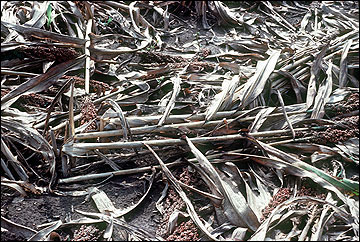 Figure 7
Figure 7
Charcoal root rot causes lodging of plants.
Management
- Plant varieties with good stalk strength; no resistant varieties are available.
- Plant in fertile soil.
- Avoid high plant populations unless irrigating.
- Reduce drought stress on the plants throughout the season and especially during the flowering and grain-filling stage of growth through irrigation.
- Rotate with cotton. Plant cotton for at least two years before planting a susceptible crop (soybeans, grain sorghum, corn) again. This will not eliminate the problem but should reduce disease severity. Quadris is EPA labeled for application to grain sorghum foliage for protection against anthracnose and gray leaf spot.
Fusarium stalk rot
Fusarium root and stalk rot, caused by Fusarium thapsinum, can affect many grasses, including grain sorghum. The disease is generally found in the same areas where charcoal rot develops. Like charcoal rot, Fusarium stalk rot is most severe in drought-stressed plants.
Symptoms
Fusarium stalk rot causes the pith in the lower stalk to appear red while the outside of the stalk remains green (Figure 8). The pith tissue usually remains intact, unlike the shredding associated with charcoal rot. Plants may die prematurely or lodge.
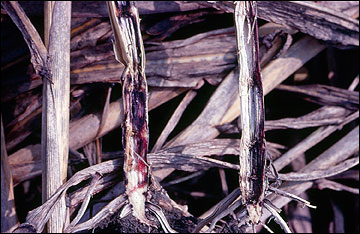 Figure 8
Figure 8
Red discoloration of stalk pith due to Fusarium stalk rot.
Management
- Plant in fertile soil.
- Plant varieties with good stalk strength.
- Avoid high plant populations unless irrigating.
- Avoid drought stress conditions through reduced tillage or irrigation.
Diseases of the heads
Smut
Smut diseases that affect grain sorghum heads in Missouri include covered kernel smut (caused by Sporisorium sorghi), loose kernel smut (caused by Sporisorium cruentum), and head smut (caused by Sporisorium reilianum). The kernel smuts are not serious problems because fungicide seed treatments control these diseases. Head smut is controlled mainly by growing resistant varieties (Figure 9).
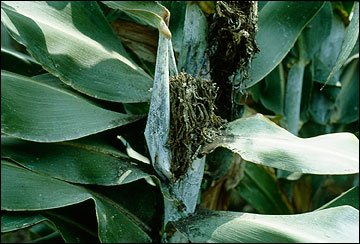 Figure 9
Figure 9
Deformation of grain sorghum head due to head smut.
Head molds
Head molds are common in Missouri, especially when rainy weather occurs after maturity. Several different fungi grow in glumes and grain surfaces, causing the heads and seeds to appear moldy. The fungi that cause head molds (Alternaria, Curvularia and Helminthosporium) usually do not cause serious yield losses but can mold grain in storage. Certain other fungi, such as Fusarium moniliforme (Fusarium head blight) and Colletotrichum graminicola (anthracnose) can attack grain and cause considerable losses under adverse weather conditions. Prolonged wet weather that delays harvesting promotes infection of grain by these fungi and yield loss may occur. Grain quality can be affected by head molds.
Mold development related to bird damage is perhaps the most serious head problem in Missouri. Flocks of birds invade sorghum fields at various stages of maturity and cause damage to the grain. Often the birds break the developing kernels. Mold may develop on the damaged grain, causing the heads to have a blackened appearance. This damage is often mistaken for smut infections.
Management
- Harvest promptly.
- Plant only fungicide-treated seed.
- Avoid varieties with compact heads.
Nematodes
Several nematodes (especially stunt, root-knot and lesion nematodes) feed on and damage grain sorghum roots. No serious nematode problems on grain sorghum have been noticed in Missouri. However, nematode damage to this crop is common in other areas, especially in the south. You should be aware of the symptoms nematodes may cause and use the proper controls where appropriate.
Symptoms
Symptoms of nematode damage can be mistaken for symptoms of other problems such as nutrient deficiency, drought and root rots. Affected plants may be stunted and off-color (yellow-green) and may wilt in the midday summer sun more readily than healthy plants. Severely affected plants will not yield as well as healthy plants. Symptoms will be more apparent in sandy soils.
The only sure way to confirm a nematode problem is to take soil and root samples from the affected area and have them analyzed for nematodes. The MU Plant Nematology Laboratory, in Columbia, 573-882-2716, can do the analysis. Contact the MU Extension center in your area about sampling techniques and forms to submit with the sample.
Management
- Sample fields to determine nematode populations.
- Rotate grain sorghum with crops that are not hosts of these nematodes.
- No nematode-resistant grain sorghum varieties are available.
Other leaf disorders
A variety of unfavorable environmental and nutritional conditions may cause symptoms on leaves:
- An excess or deficiency of soil nutrients or water
- Extremely high or low soil pH
- Extremely high or low temperatures
- Air pollutants
- Injuries from pesticides
- Mechanical injury
Environmental conditions can sometimes cause symptoms on the leaves that can be confused with symptoms produced by bacteria and fungi. A common condition in grain sorghum in Missouri is the presence of black leaf spots without any other signs of infection. Most of this nonparasitic spotting is due to mechanical injury from insect punctures, wind whipping or wind-blown sand particles. New leaves generally will not be affected.